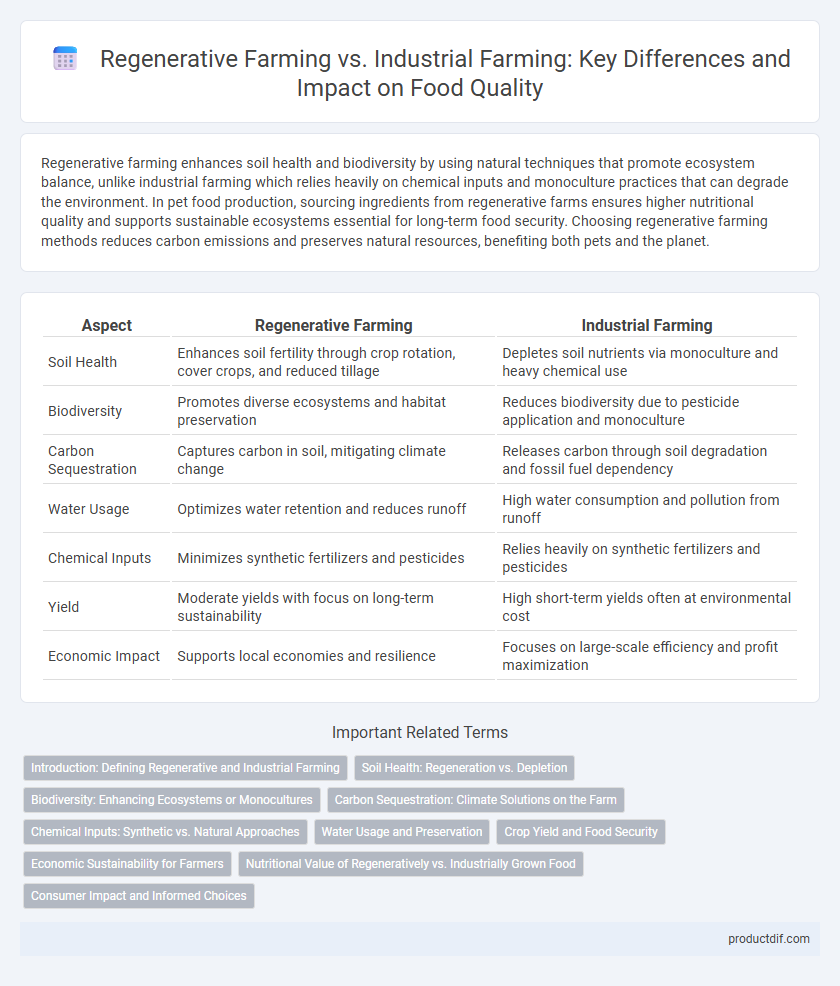Regenerative farming enhances soil health and biodiversity by using natural techniques that promote ecosystem balance, unlike industrial farming which relies heavily on chemical inputs and monoculture practices that can degrade the environment. In pet food production, sourcing ingredients from regenerative farms ensures higher nutritional quality and supports sustainable ecosystems essential for long-term food security. Choosing regenerative farming methods reduces carbon emissions and preserves natural resources, benefiting both pets and the planet.
Table of Comparison
| Aspect | Regenerative Farming | Industrial Farming |
|---|---|---|
| Soil Health | Enhances soil fertility through crop rotation, cover crops, and reduced tillage | Depletes soil nutrients via monoculture and heavy chemical use |
| Biodiversity | Promotes diverse ecosystems and habitat preservation | Reduces biodiversity due to pesticide application and monoculture |
| Carbon Sequestration | Captures carbon in soil, mitigating climate change | Releases carbon through soil degradation and fossil fuel dependency |
| Water Usage | Optimizes water retention and reduces runoff | High water consumption and pollution from runoff |
| Chemical Inputs | Minimizes synthetic fertilizers and pesticides | Relies heavily on synthetic fertilizers and pesticides |
| Yield | Moderate yields with focus on long-term sustainability | High short-term yields often at environmental cost |
| Economic Impact | Supports local economies and resilience | Focuses on large-scale efficiency and profit maximization |
Introduction: Defining Regenerative and Industrial Farming
Regenerative farming enhances soil health, biodiversity, and ecosystem resilience by using practices such as cover cropping, crop rotation, and reduced tillage, promoting sustainable food production. Industrial farming relies on monoculture, synthetic fertilizers, and pesticides to maximize crop yields but often results in soil degradation and environmental harm. Understanding these definitions highlights the contrast between methods prioritizing long-term ecological balance and short-term productivity.
Soil Health: Regeneration vs. Depletion
Regenerative farming enhances soil health by increasing organic matter, promoting microbial diversity, and improving water retention, which leads to long-term fertility and ecosystem resilience. Industrial farming depletes soil nutrients through intensive monocropping, heavy chemical use, and erosion, causing soil degradation and loss of productivity over time. Practices like cover cropping and reduced tillage in regenerative systems restore soil structure, whereas conventional methods accelerate soil compaction and nutrient depletion.
Biodiversity: Enhancing Ecosystems or Monocultures
Regenerative farming enhances ecosystems by promoting biodiversity through crop rotation, cover cropping, and reduced chemical use, which supports soil health and diverse wildlife habitats. Industrial farming relies heavily on monocultures, leading to soil degradation, reduced biodiversity, and increased vulnerability to pests and diseases. The contrasting approaches directly impact ecosystem resilience and long-term agricultural sustainability.
Carbon Sequestration: Climate Solutions on the Farm
Regenerative farming enhances carbon sequestration by increasing soil organic matter through practices like cover cropping and reduced tillage, effectively capturing atmospheric CO2. Industrial farming relies heavily on synthetic inputs and intensive tillage, which degrade soil health and release stored carbon, contributing to greenhouse gas emissions. Emphasizing regenerative techniques offers a viable climate solution by restoring soil carbon pools and improving ecosystem resilience on farms.
Chemical Inputs: Synthetic vs. Natural Approaches
Regenerative farming relies on natural inputs like compost, cover crops, and biological pest control to enhance soil health and biodiversity, reducing dependence on synthetic chemicals. Industrial farming predominantly uses synthetic fertilizers, pesticides, and herbicides to maximize crop yields but often leads to soil degradation and environmental pollution. Choosing natural approaches in regenerative agriculture promotes sustainable food production and long-term ecosystem resilience.
Water Usage and Preservation
Regenerative farming significantly reduces water usage through techniques like cover cropping, mulching, and soil aeration, which enhance soil moisture retention and decrease runoff. Industrial farming often relies on heavy irrigation and monoculture practices that deplete water resources and contribute to soil erosion and contamination. By prioritizing water preservation, regenerative agriculture supports sustainable water cycles and improves ecosystem health.
Crop Yield and Food Security
Regenerative farming improves soil health through practices like cover cropping and crop rotation, enhancing long-term crop yield stability and resilience against climate variability. Industrial farming often achieves higher immediate yields using synthetic fertilizers and monocropping but risks soil degradation and reduced biodiversity, threatening future food security. Prioritizing regenerative methods supports sustainable food production and bolsters global food security by maintaining ecosystem balance.
Economic Sustainability for Farmers
Regenerative farming enhances economic sustainability for farmers by improving soil health, reducing input costs, and increasing long-term yield resilience. Industrial farming often relies on expensive synthetic inputs and large-scale equipment, leading to higher operational costs and vulnerability to market fluctuations. Emphasizing regenerative practices supports diversified income streams and mitigates financial risks, promoting stable farm economies.
Nutritional Value of Regeneratively vs. Industrially Grown Food
Regeneratively grown food typically exhibits higher nutritional value due to enriched soil health and increased biodiversity fostering essential micronutrients and antioxidants. Industrial farming often relies on synthetic fertilizers and monocultures, leading to nutrient depletion and reduced vitamin and mineral content in crops. Research shows regeneratively farmed produce contains up to 40% more vitamins, minerals, and phytochemicals compared to conventionally grown counterparts.
Consumer Impact and Informed Choices
Regenerative farming enhances soil health and biodiversity, resulting in nutrient-dense food that supports consumer well-being and environmental sustainability. Industrial farming often prioritizes yield and cost-efficiency, potentially compromising food quality through pesticide use and soil depletion. Consumers informed about these differences can make choices that promote health and ecological balance by opting for products from regenerative practices.
Regenerative farming vs Industrial farming Infographic

 productdif.com
productdif.com